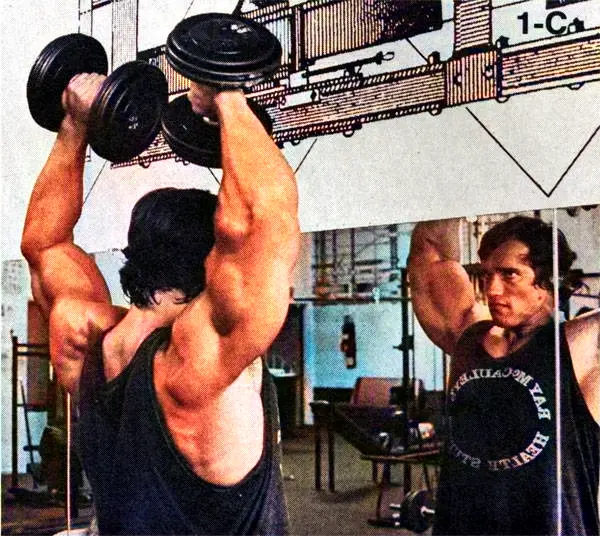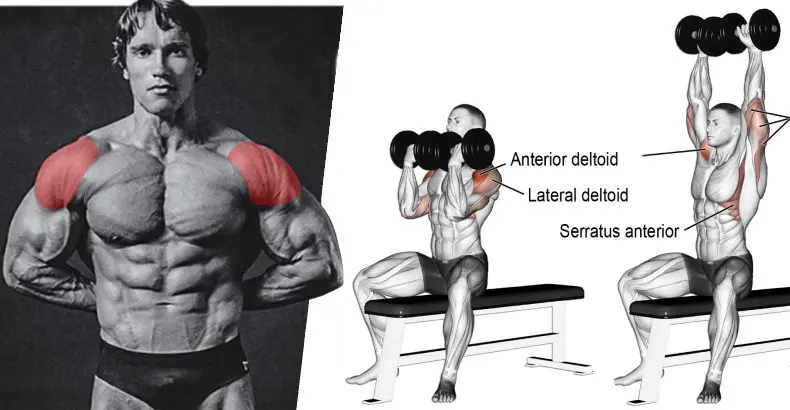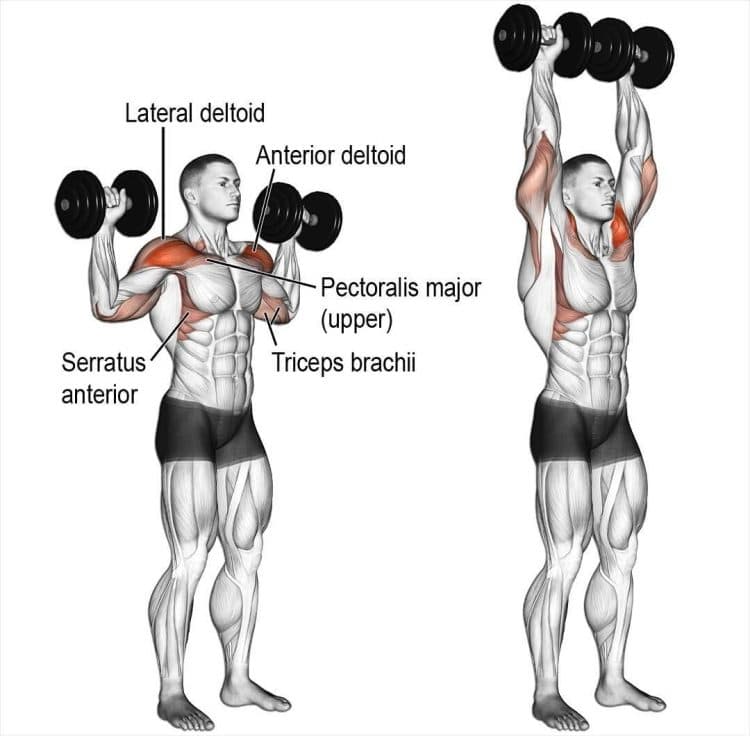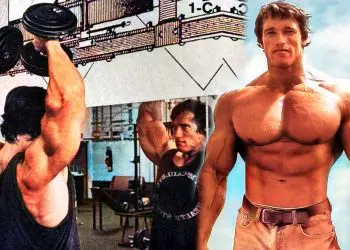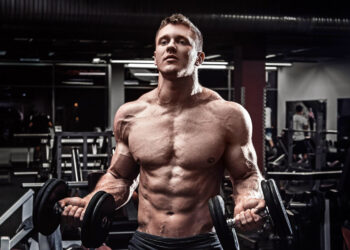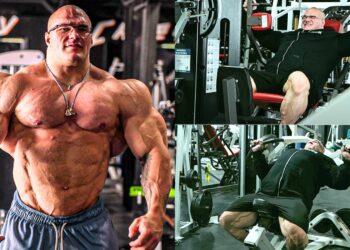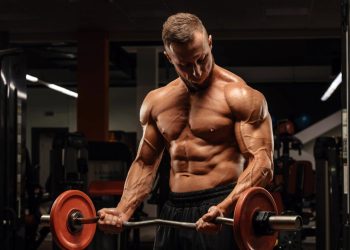Your shoulders are involved in every chest and back exercise you do. They act as synergists (helpers) and stabilizers whenever you do bench presses, cable crossovers, pull-ups, or seated rows. Because of this, a lot of exercisers don’t put a lot of emphasis on training their shoulders.
That’s a mistake!
Well-developed shoulders add a lot to your appearance, giving you a wider, more imposing upper body that accentuates that all-important V-taper. Also, big shoulders stand out even when you are wearing regular clothes. In your training vest, they’re impossible to miss.
While exercises like lateral raises and face pulls can help shape your shoulders, when it comes to building cannonball deltoids, overhead pressing is a must. Overhead presses are arguably the most effective way to add mass to your deltoids. They are also useful for bulking up your triceps.
There are several overhead pressing exercises to choose from. Still, two of the best are the Arnold press and dumbbell shoulder press. In this article, we compare these two classic shoulder builders so you can pick the best one for your bodybuilding workouts.
Arnold Press Exercise 101
Level Up Your Fitness: Join our 💪 strong community in Fitness Volt Newsletter. Get daily inspiration, expert-backed workouts, nutrition tips, the latest in strength sports, and the support you need to reach your goals. Subscribe for free!
While he probably didn’t invent this exercise, the Arnold press is named after legendary bodybuilder Arnold Schwarzenegger. The Seven-time Mr. Olympia winner frequently used this exercise, and so, it will always be associated with him.
Arnold had amazing deltoids. And while he used a range of exercises to sculpt his championship-winning shoulders, it’s safe to say that the Arnold press played an important part in his success.
The Arnold press is done using dumbbells and is a type of overhead press. However, this exercise involves a unique arm action that increases deltoid activation. As such, it’s a very popular exercise with bodybuilders.
Muscles Worked
The Arnold press is a compound exercise, which means it involves several muscles and joints working together. The primary muscles developed by the Arnold press are:
Deltoids – the deltoids are your main shoulder muscles. There are three sets of fibers or heads that make up the deltoids:
- Anterior – front
- Medial – middle (also known as the lateral head)
- Posterior – rear
Arnold presses work all three deltoid heads, making them a very balanced, time-efficient exercise.
Triceps – located on the back of the upper arm, the triceps are responsible for extending your elbows.
Rotator cuff – this is the collective term for the deep shoulder muscles that stabilize the head of your humerus and control the finer movements of the shoulder joint. The muscles that make up the rotator cuff are the supraspinatus, infraspinatus, teres minor, and subscapularis (1).
How to do Arnold presses
- Hold a dumbbell in each hand. Raise the weights up, so your arms are bent, and the dumbbells are in front of your shoulders, palms facing your face. This should look like you’ve just finished a biceps curl. Pull your shoulders down and back, lift your chest, and brace your core.
- Next, spread your elbows and simultaneously press the weights up and overhead, twisting your wrists, so your palms are facing forward as your arms straighten. Stop just short of fully locking your elbows.
- Lower the weights back to the starting position by reversing this movement.
* The Arnold press can be done seated or standing as preferred.
Arnold Press – Pros
Not sure if the Arnold press is the right shoulder exercise for you? Consider these benefits before making your final decision!
Increased time under tension – a rep of Arnold presses takes longer to perform than a rep of regular overhead presses. That’s because of the extra movement at the start. This may trigger greater hypertrophy by creating more metabolic stress.
Hit all three deltoid heads – regular overhead presses emphasize the anterior or front deltoid. The Arnold press hits all three heads for a more time-efficient workout and more balanced shoulder development.
Named after a legendary champion! – this exercise worked wonders for Arnie, and it could do the same thing for you, too. While this isn’t a huge pro, it’s nice to know you’re doing a bodybuilding exercise with such strong historical links.
Arnold Press – Cons
There are a couple of drawbacks to consider before you add the Arnold press to your deltoid workouts:
Shoulder impingement – the Arnold Press combines shoulder joint flexion and extension with rotation, which increases the risk of shoulder impingement. This occurs when the rotator cuff rubs against the humerus (arm bone) and the top outer edge of your shoulder socket. This friction can cause irritation and pain, and reduce your range of motion.
Avoid the Arnold press if you have a history of shoulder impingement or find that this exercise causes shoulder pain.
Wrist pain – rotating the dumbbells as you press them overhead puts more stress on your wrists than regular shoulder presses. If you have weak or sore wrists, the Arnold press could make matters worse. Wearing wrist wraps could help, as will working on your forearm and grip strength.
Dumbbell Shoulder Press 101
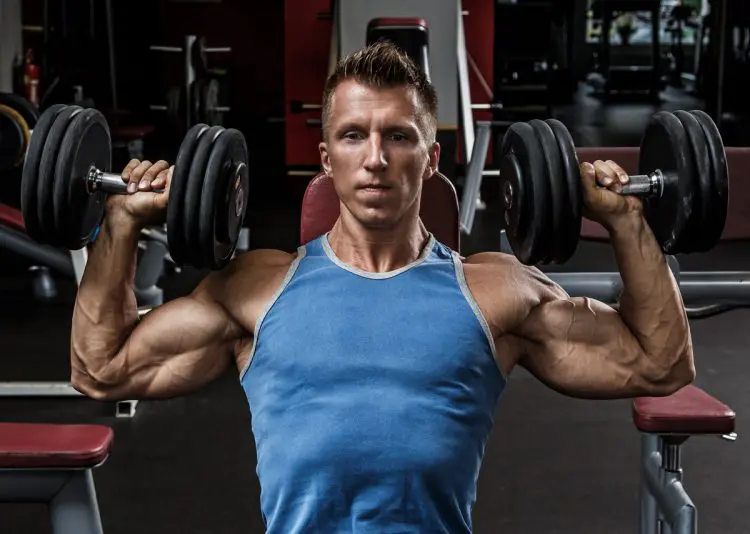
The dumbbell shoulder press is a staple of shoulder training for many exercisers. In fact, it’s probably one of the most commonly performed overhead pressing movements. The dumbbell shoulder press can be done seated or standing and is a valuable mass and strength builder.
Dumbbell shoulder presses are a very traditional shoulder exercise. They have been in use for as long as people have been lifting weights.
Muscles Worked
Like the Arnold press, dumbbell shoulder presses are a compound exercise that works several muscles at the same time. The muscles trained during dumbbell shoulder presses are:
Deltoids – like the Arnold press, dumbbell shoulder presses involve all three deltoid heads. However, it’s the front or anterior deltoids that do most of the work, acting as the agonists. The medial and posterior deltoids are involved more as stabilizers.
Triceps – located on the back of the upper arm, the triceps are responsible for extending your elbows.
Rotator cuff – this is the collective term for the deep shoulder muscles that stabilize the head of your humerus and control the finer movements of the shoulder joint. The muscles that make up the rotator cuff are the supraspinatus, infraspinatus, teres minor, and subscapularis.
Level Up Your Fitness: Join our 💪 strong community in Fitness Volt Newsletter. Get daily inspiration, expert-backed workouts, nutrition tips, the latest in strength sports, and the support you need to reach your goals. Subscribe for free!
How to do dumbbell shoulder presses
- Hold a dumbbell in each hand. Lift them up so that your upper arms are roughly parallel to the floor, palms facing forward. Brace your abs, lift your chest, and pull your shoulders down and back.
- Keeping your elbows back and chest open, press the weights up and overhead, so they follow an arc. Bring the weights together above your head as you straighten but don’t lock your elbows.
- Lower the weights out and down to your shoulders and repeat.
* You can do dumbbell shoulder presses seated or standing as preferred.
Dumbbell Shoulder Press – Pros
Not sure if dumbbell shoulder presses are the best exercise for you? Take a look at this list of benefits:
Emphasize your anterior deltoids – if you want to build bigger front delts, the dumbbell shoulder press is a good choice. The simplistic movement means you can lift plenty of weight and focus more on pressing the weights up.
Straightforward movement – dumbbell shoulder presses require very little coordination or finesse. Just grab the weights and push them overhead. This makes them easy to learn and also more suitable for heavy weights.
Less shoulder joint stress – compared to the Arnold press, dumbbell shoulder presses are easier on your shoulder joints. With no rotation to worry about, the risk of impingement is considerably lower.
Dumbbell Shoulder Press – Cons
Like all exercises, there are drawbacks to dumbbell shoulder presses, too…
Difficulty getting heavy weights into the starting position – the most challenging part about doing dumbbell shoulder presses with heavy weights is getting the weights into the correct starting position. You’ll either need to clean them up to your shoulders or, if seated, use your legs to boost them up. Either way, barbell presses from a rack may be more convenient if you want to lift heavy weights.
Arnold Press vs. Dumbbell Shoulder Press
So, now that you know a little more about Arnold presses and dumbbell shoulder presses, let’s judge these exercises by a few different criteria:
Strength
The Arnold press involves a larger range of motion, a longer time under tension, and a more awkward starting position than dumbbell shoulder presses. As such, you’ll probably find that you can shoulder press more than you can Arnold press. Because of this, the dumbbell shoulder press is the better choice if you want to build strength.
Hypertrophy
The whole point of the Arnold press is to maximize deltoid hypertrophy. It’s an exercise from the sport of bodybuilding, which suggests it’s excellent for hypertrophy. While dumbbell shoulder presses will build bigger muscles, the Arnold press is more hypertrophy-specific.
Safety
Both the Arnold press and dumbbell overhead press can be performed safely. If you cannot complete a rep, all you need to do is lower the weights down, out, and away from your head. While there is nothing wrong with using one, there is no need to have a spotter for either of these exercises.
That said, Arnold presses put more stress on the rotator cuff muscles, which could lead to shoulder injuries. As such, in terms of long-term safety and injuries, the dumbbell shoulder press is arguably the safer of the two exercises.
Ease of learning
Dumbbell shoulder presses involve a very straightforward movement. Just raise the weights to shoulder height and then press them overhead; simple! Arnold presses involve move coordination and a larger range of motion, making them technically more challenging.
Neither of these exercises is especially tricky to learn, but dumbbell shoulder presses are simpler and probably better for beginners.
Equipment
The equipment needed to do these two exercises is the same – a pair of dumbbells. You can also do them seated, using a flat bench or an upright bench if you want more back support. With so little equipment required, you should have no problem doing either of these exercises in even a sparsely-equipped commercial, home, or garage gym.
Long-term progression
You’ll probably be able to continue adding weight for longer with conventional dumbbell shoulder presses. It’s a more straightforward, stronger movement that is well suited to heavy weights.
The Arnold press involves a more intricate movement, and the starting position is not especially strong. As such, your performance will probably stall sooner with Arnold presses.
Variety
One of the best ways to avoid training ruts is to change your workout from time to time and use variations of your main exercises. In many cases, simply altering the width of your stance or the angle of your bench is all that’s needed to avoid progress plateaus.
While switching from Arnold presses to dumbbell shoulder presses or vice versa is an excellent way to add some variation to your workout, both exercises can be done in several different ways to ensure that you keep making progress, e.g.:
- Seated or standing
- Alternating
- Single-arm
- With kettlebells instead of dumbbells, which increases anterior deltoid activation (2)
- With resistance bands instead of weights
While we haven’t counted them all, there are roughly the same number of variations for both dumbbell shoulder presses and Arnold presses.
Wrapping Up
While there is nothing wrong with side lateral raises and reverse flyes, if you want monstrously muscular, strong shoulders, you need to include overhead presses in your workouts. Barbell military presses are a good choice, but if you do them too often, they’ll soon start to lose some of their potency, and your workouts could become boring.
Using dumbbells is a great option and is often more shoulder joint-friendly.
There are lots of dumbbell pressing exercises for better shoulder development, but the main variations are Arnold presses and standard dumbbell shoulder presses.
But which one is best?
The reality is that both these exercises are very effective. However, Arnold presses are marginally better for hypertrophy, while dumbbell shoulder presses could be better for building strength. However, Arnold presses may also be a little harder on your rotator cuff and shoulder joints.
Ultimately, you should choose the one that best matches your training goals. Or, if you can’t pick between them, use them both, alternating from one workout program to the next. That way, you can enjoy the benefits of both these excellent exercises.
Whichever one you choose, it’ll help you build shoulders you can be proud of!
References:
1 – PubMed: Anatomy, Rotator Cuff https://www.ncbi.nlm.nih.gov/books/NBK441844/
2 – PubMed: Stability of Resistance Training Implement alters EMG Activity during the Overhead Press https://www.ncbi.nlm.nih.gov/pmc/articles/PMC6033506/
Interested in measuring your progress? Check out our strength standards for Bench Press, Face Pull, Arnold Press, and more.

